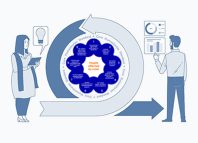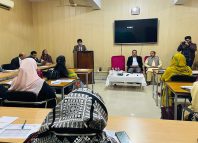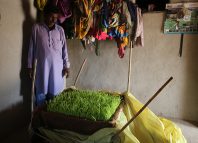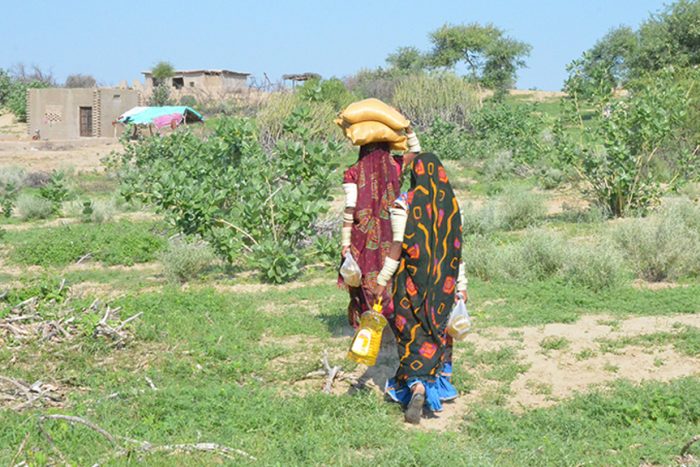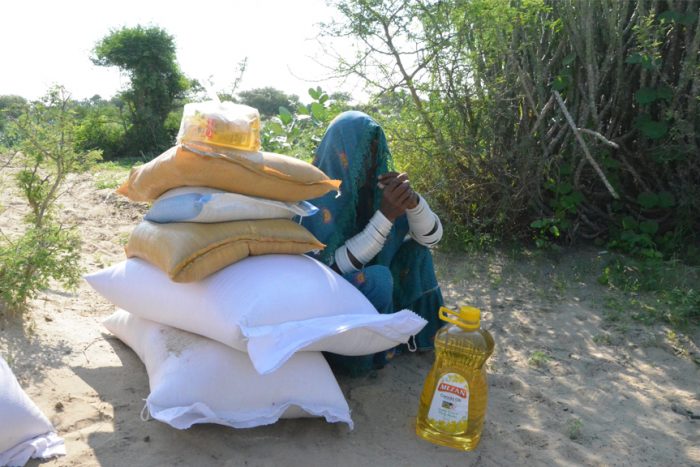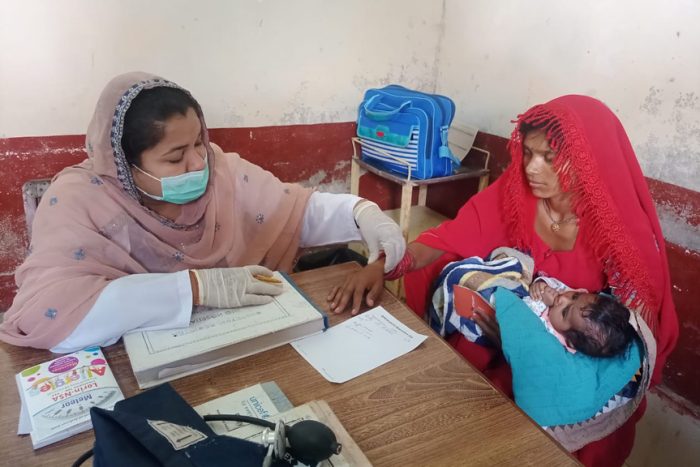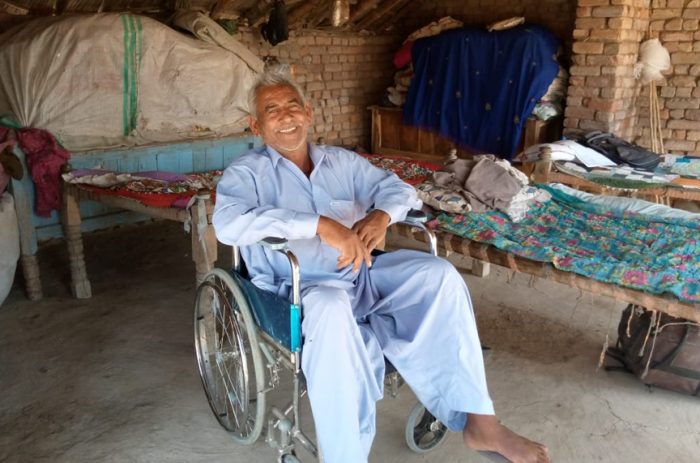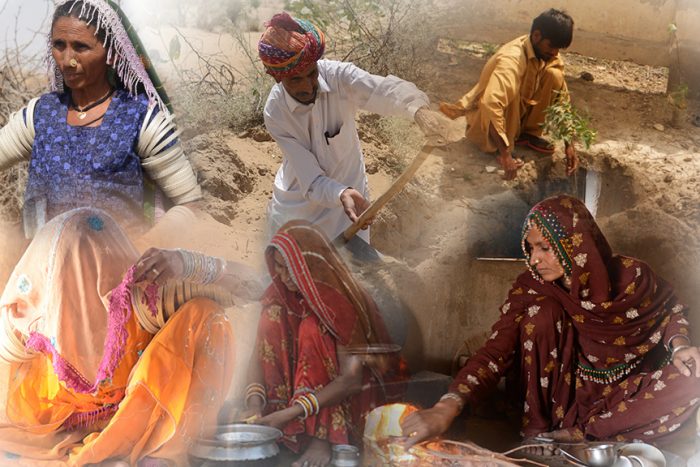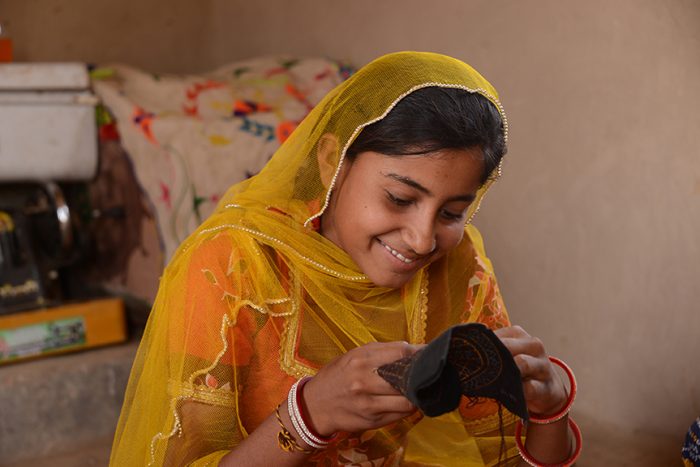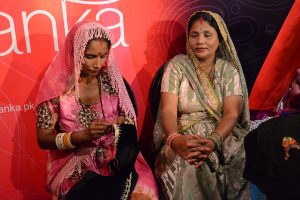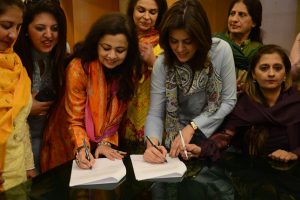Community World Service Asia is supporting local and provincial education programs in promoting sustainable quality education for both boys and girls in various parts of the region. One of its programs focuses on ensuring quality education in Umerkot and is implemented in collaboration with government bodies, school management committees, teachers, the local communities and other relevant stakeholders. Despite the various obstacles experienced in the operational environment owing to COVID-19, CWSA continued to provide educational opportunities for underserved communities in Umerkot. By increasing the quality of education and eliminating the literacy gap between boy and girl students and empowering women and girls, CWSA strives to provide inclusive and equitable quality education and gender equality.
Archives
A ray of hope and a chance of a better future for Seeta and her daughters
“This humanitarian assistance will enable me to meet my family’s food needs for more than a month. The millet seeds will assist me in reviving my agricultural livelihood, which I want to pursue with the help of my nephew and son-in-law in make a better living. This will enable me to send my girls to school so that they may receive an education and have a brighter future. This help came at the perfect time, just when we were struggling to afford a single meal a day even,” Seeta explained.
The Village Management Committeeⁱ of Sheedi Jo Tarr village identified Seeta as a project participant under Community World Service Asia and UMCOR’s relief projectⁱⁱ. The project is supporting climate induced disaster affected families with the provision of food packages and seasonal seeds for harvesting in the upcoming farming season.
Seeta, a widow belonging to and living in Sheedi Jo Tarr village of Umerkot district, does not have any children of her own but has in fact adopted four daughters of her nephew and has raised them as her own. “I got married at a very young age. I was only 16 years old. While my husband was alive, we decided to adopt two of my nephew’s daughters. We have nurtured them as our own, and we adore them. We married our eldest daughter off at the age of 20 in 2009. It was a very joyous moment for us,” shared Seeta.
Seeta’s husband, Geneso, died of a heart attack in 2010. Following Geneso’s death, Seeta’s nephew’s other two daughters became close to her, as her nephew left them with her when he and his wife went to work in the fields. Seeta would care for the three children by herself all day, and the two younger daughters grew to love her and refused to live with their parents. As a result, Seeta has been caring for the three children on her own since then. Her nephew had a meagre income and would give Seeta a portion of it to help her care for his children. However, this was insufficient to meet all of the children’s necessities. “My husband worked in the farming industry. He had rented acreage and cultivated a variety of crops on it. I occasionally assisted him in his agricultural endeavours. However, after he passed away, it became impossible to make a decent living, as I was caring for my three girls alone. The money did not come in as frequently as it used to. I could not work in the fields on a regular basis because I had to care for my house and girls. However, I used to be able to pick cotton and chilli occasionally to earn a little money.
Our neighbours and relatives sometimes offered cash assistance, but it was insufficient to meet our family’s basic needs. At 69 years now, working to earn a living for my family has become too exhausting for me. My daughters help me at home, but I want them to go to school so they may have a better future. My ten-year-old daughter has completed her basic schooling. The two younger ones, who are five and three years old, on the other hand, have not been enrolled in school yet. Unfortunately, I am unable to cover the costs of their schooling,” Seeta explains.
Seeta received the food package on October 8th, along with 516 other families at a distribution activity held in her village. The food package consisted of wheat flour, rice, cooking oil, pulse, sugar, tealeaves, iodized salt, matchbox and millet. “Since receiving the food package, we have been eating wholesome meals on a daily basis. My nephew and son-in-law have offered their assistance in preparing the field for millet seed sowing. We now have hope of making money from our agricultural efforts, and I intend to enrol my girls in school,” Seeta concluded.
ⁱ A community-based structure consisting of key community members, both men and women, who coordinate with and support the project team during project interventions.
ⁱⁱ Humanitarian and recovery support to the vulnerable communities continuously affected by recurrent disasters
Providing food security and livelihood sustainability to most vulnerable, climate change affected families in Umerkot, Pakistan
Bai lives in Umerkot’s Rajari village with her spouse Ramji. Bai was born with a physical disability and is unable to walk on her own. Ramji is unable to see, and has been declared blind by doctors since he was five years old owing to an eye infection. Bai and Ramji were married to each other by their parents when Bai was 26 and Ramji was 29 years old and now are parents to two children; a son named Veeram and a daughter, Samina.
The couple earned a living through beggary in the neighbourhood and lived in a one-room house offered to them by fellow villagers in Rajari. They would go house to house or wandered in the streets until someone gave them some charity money.
“We have always wanted our children to go to school and make a better life for themselves. Unfortunately, we are unable to give them that right as we barely make ends meet by the money we receive. Our income is not steady as it depends on the charity of others. Our children also beg with us occasionally,” added Bai sadly.
Four years ago, when Veeram turned 16 years, he started working as a farmer at the local agricultural fields. He was would earn an income of PKR 7000 each month (Approx. USD 40). “Veeram is a dedicated and hardworking individual. He despised begging and felt awful whenever he saw his younger sister, Samina, begging on the streets. He was anxious to find work and support his family and stop them from begging,” Bai explained, “We stopped begging as Veeram began to provide a source of money for the family. We were living a very simple and happy life since we didn’t have to rely on begging or on someone else’s generosity for a living.”
Veeram planted cluster beans, mung beans, wild melon, millet, and sesame among other crops. He farmed the crops on a two-acre plot of land he rented from his landlord. The landlord received fifty percent of the produce as rent.
The majority of the union council that Rajari is located, is a rain-fed area, and agriculture is solely reliant on rain showers during the monsoon season, which occurs between July and August every year. Unfortunately, Rajari along with other villages did not receive enough rain this year, and subsequently the agricultural production did not meet expectations. “Veeram was unable to find work in agriculture since it became nearly impossible to harvest without rain water. We had to borrow money from the landowner to make ends meet. Veeram took a loan of PKR 10,000(Approx. USD 57) to buy groceries and cover other household costs.”
Many families in Rajari and surrounding villages were affected by the drought and the locust invasion and were left with no source of livelihood, driving them to poverty and famine. To support these affected communities, Community World Service Asia and its partnersⁱ, provided food packages and millet seeds to 516 households in the area. Each food package contained wheat flour, rice, cooking oil, pulses, sugar, tealeaves, iodized salt, matchbox, and millet. These packages have been developed to alleviate food insecurity among climate change affected communities while also enabling them to self-sustain themselves through agricultural activities.
Bai’s family was identified and selected as a project participant to receive the food package by the Village Management Committeeⁱⁱ. Bai received the food package on October 8th during the distribution activity conducted in Punhoon Bheel village, which is a kilometre away from Bai’s home.
“I was overwhelmed when I heard that our family will be receiving assistance. The food package includes nutritious food items that will last us for a good two months, as we are only four members in the family. At the distribution day, it began to rain. We are more optimistic that we will be able to cultivate the millet seed included in the package, and that my son will be able to find labour in the fields. This support has given us hope when we had no hope left and nowhere to go,” shared Bai.
Promoting Disaster Reduction & Preparedness among Affected Communities and the Local Aid Sector









Improving Access to Maternal Healthcare for remote and underprivileged communities in rural Sindh
Twenty-three year old Diya lives in Ramchand Khatri village of Umerkot which is located at a five kilometres distance from Community World Service Asia’s Maternal, Neonatal and Child Health (MNCH) centre in the same district. Diya first visited the MNCH centre with complains of nausea, vomiting, and weakness in October last year.
After thoroughly examining Diya, the lady health visitor at the centre advised her to take a pregnancy test, which came out to be positive. Diya was expecting her first child. “My haemoglobin was low at 9.0 when I first visited the MNCH. The medical officer advised for antenatal care (ANC) and prescribed multivitamins to me to address the weakness and normalise my haemoglobin levels. My ANC card was created, and I was scheduled for a follow-up appointment in one week.”
The following week Diya went for her follow-up examination at the MNCH where the doctor further prescribed Monofer Injections for her increasing weakness and low haemoglobin levels. “My mother-in-law was concerned about my well-being. But her anxiety was reduced when she accompanied me to the MNCH to observe how effectively the medical personnel attended to my needs and treated me.”
Ramchand Khatri is a remote village in Umerkot, with limited livelihoods opportunities and no immediate access to education, electricity, safe drinking water, health facilities or fully constructed roads. “My husband works as a farmer. During the harvest season, my husband receives his share of the crop after cultivation,” shared Diya. “Other days, we survive on the loan we take from the landowner my husband works for. Sometimes when he is able to find other labour work, he is able to earn a small income. Our total monthly income barely adds up to PKR 8000 (Approx. USD 51). Therefore, we have not been able to set aside any funds for healthcare.”
Diya has been going to the health centre for her antenatal care on a regular basis. She is in her last month of pregnancy now. “We are unable to afford good healthcare services offered at the city hospital so this is a blessing for us,” Diya’s husband said, expressing his satisfaction with her treatment at the MNCH. “We were concerned about how we would be able to afford and provide good healthcare to Diya as we found out about our pregnancy. Our concerns, however, dissolved soon after we visited the MNCH. Diya’s haemoglobin level improved and normalised as a result of her regular antenatal care appointments. The medical team at the centre have treated Diya proactively and the baby and her appear to be in good health.”
Giving a sense of hope for differently-abled people in rural villages of Sindh, Pakistan
Lalo is from a small village in Umerkot’s Pithoro tehsil[1] called Achhlo Kolhi which mainly homes a Kolhi[2] community settlement, consisting primarily of farmers from a religious minority population in Sindh. The village is located at a 10 kilometres distance from Community World Service Asia’s Maternal, Neonatal and Child Health (MNCH) center in Pithoro, which was set up under its health project[3] in collaboration with Act for Peace. The Kolhi community have limited livelihood prospects due to their heavy reliance on agriculture and many of them are living below the poverty line. Currently, eighty of the Kolhi households in the village even lack basic amenities such as safe drinking water, education, and health care.
Lalo supported his wife and seven children working as an agrarian farmer for long hours on agricultural fields in the area. His elder sons also worked on the fields with him and the family survived and sustained on the income from the farming on a day to day basis. Something tragic that happened last year (2020) deprived Lalo of this livelihood, changing his life forever and left the family in a crumbling state.
“Working in the agricultural fields provided me with a monthly income of PKR 10,000 (Approx. USD 63). In April of 2020, I paid a visit to a relative of mine, Geno, who lived in a nearby village, Bacha Band, during monsoon season and it was raining heavily. We were in a room when the roof fell over us, burying us beneath the rubble. Both of us were seriously injured and were transported to the hospital straight away. Geno succumbed to his injuries after a month in the hospital. While I was left with a crushed femur (thighbone) and have been unable to walk since.”
Lalo was well known for his social skills and actively socialised within the community. He was a hardworking father and husband who worked for hours in the agricultural fields, collected fodder for the animals daily, visited the nearest town to buy household groceries and happily took part in all religious rituals and family events. However, the accident changed this lifestyle of Lalo. It became very difficult for him to manage anything on his own. Most of his days were spent lying down in bed, as he struggled to move about with only his hands. Lalo could not work on the fields anymore, an activity he had grown accustomed to and was a sole source of income for his family and him.
With the help of the wheelchair, Lalo has been more mobile and is able to attend to some household chores as well as socialise as he used to. “At times when I felt more pain, I have not been able to visit the MNCH. However, now I am able to visit the health centre when needed. I am also participating in our religious rituals again. This initiative has given me hope to come back to the normal life I had and step towards a good and healthy life.”
[1] In Pakistan, a tehsil (or taluka) is an administrative sub-division of a District. Those are sub-divided into union councils.
[2] Kolhi is a subgroup of Koli community native to Sindh, Pakistan. Kolhi’s mostly are Hindu but some of them are Christian and Muslim.
[3] Umerkot Health Project, implemented by Community World Service Asia and funded by Act for Peace
Enabling remote communities to timely detect and address Malnutrition among Children in Sindh
The Community-based Management of Acute Malnutrition (CMAM) Surge Approach is designed to enable health systems to effectively treat children diagnosed with acute malnutrition. The CMAM approach relies on the assumption that the number of children with acute malnutrition increases drastically at certain times of the year in many places. Low birth weight owing to poor maternal nutrition, protein-energy malnutrition, anaemia, and iodine deficiency are all major nutritional issues in Pakistan. Since 2013, Pakistan has been a part of the worldwide Scaling Up Nutrition (SUN) effort to address these nutritional issues. Sindh is severely affected by intensifying malnutrition and stunting indicators. As many as 48 percent children under the age of five are stunted while 35pc of them are severely stunted[1].
Aware of the rising rates of acute malnutrition among remote and impoverished communities of rural Sindh, the People’s Primary Healthcare Initiative (PPHI)[2] of Sindh, in collaboration with Community World Service Asia, conducted orientation sessions on CMAM Surge Approach for community-level implementation for early diagnosis and referral of malnourished children in Umerkot district of Sindh.
In June, awareness and orientation sessions on CMAM Surge approach were held in two villages of Umerkot where forty members (both men and women) of village level Health Management Committees (HMC) participated
The sessions focused on the CMAM Surge Model that seeks to improve the resilience of health systems to be able to deliver more efficient and effective medical and preventive treatment for acute malnutrition over time. The focus was on providing the best care during times when cases are at a peak and the need for health services to address these cases is the highest. The potential to save maximum lives is at its greatest then, while ensuring that the capacity and accountability of the public health sector is not undermined.
The CMAM Surge applies an eight step approach to assist health teams in responding to rapid changes in capacity and caseloads. The scaling up of CMAM Surge has resulted in additional learning and adjustments to the methodology that are context-specific. The sessions were facilitated by PPHI and along with thorough learning on the CMAM, nutritional plans, relevant reading material, referral slips and brochures were shared with participants.
In the last six months, 45 cases of malnutrition have been recorded at the MNCHs of Samaro and Pithoro as a result of insufficient food and an absence of a balanced diet. Participants learned about the prevalence of malnutrition and its causes, particularly among children. During the sessions, participants were made aware of the many different forms of malnutrition and how to prevent it. The importance of breastfeeding and consuming a well-balanced diet were stressed upon with participants. A practical exercise was also conducted where participants learned how to measure lactating and pregnant women and children using the Mid-upper Arm Circumference (MUAC) tape.
Learnings of HMC Members:
“I knew very little about malnutrition and the services provided by PPHI to alleviate malnutrition in Sindh. We learned a lot about identifying cases of malnutrition and when and how to refer them to doctors. I will now be able to check children for malnutrition and, if necessary, refer them to the nearest PPHI centre. I also learned that malnutrition is not a disease, but rather a result of human negligence, poverty, unsanitary conditions, and food insecurity. I will sensitise people in my community to maintain hygiene at home and their neighbourhood and provide a healthy diet to their children to avoid malnutrition.”
Chetan Kumar, member of Health Management Committee in Samaro
“The CMAM Surge Model approach is a great way to assist health systems offer treatments to children with acute malnutrition more effectively. Members of the HMC will be able to predict when seasonal caseload surges are likely to occur and will use this information to better prepare themselves for management of services during times of high demand. We were able to gain a thorough understanding of malnutrition, its causes, and how to prevent it. We are now better equipped to refer malnourished children to the nearest PPHI centre for treatment.”
Nabi Bux Solangi, member of Health Management Committee in Samaro
“We discovered that the MUAC is utilised to determine nutritional status of women and children. Because it is simple and inexpensive to use, we can efficiently apply it for active case finding. MUAC is an effective indicator of mortality risk associated with malnutrition, it is therefore a better measure to identify children most in need of treatment. The use of MUAC tape will allow me to immediately refer children with acute malnutrition to doctors in a timely manner.”
Lachmi, member of Health Management Committee in Samaro
“It was my first nutrition training session, and it was a great learning experience. Malnutrition awareness is critical in our community, and individuals must understand how to prevent it. The knowledge on malnutrition, its prevention, and the usage of MUAC tape will help in the mitigation of malnutrition in our village, Mirashah.”
Shanti, member of Health Management Committee in Pithoro
“We were not aware of PPHI’s nutrition program being operated in our vicinity. This session improved our knowledge of malnutrition and its many forms, as well as the use of MUAC tape and the referral of suspicious cases to the PPHI health centre for treatment.”
Sisliya, member of Health Management Committee in Pithoro
[1] https://www.dawn.com/news/1426604
[2] Footnote: PPHI Sindh is a not-for-profit company setup under section 42 of The Companies Act 2017. PPHI Sindh has focused on mother and child health and has continuously improved delivery coverage all over Sindh.
Raising Awareness & Mobilising Action to Restore our Ecosystem
World Environment Day 2021
For too long, we have been exploiting and destroying our planet’s ecosystems. Ecosystem loss is depriving the world of carbon sinks, like forests and peatlands, at a time humanity can least afford it. Global greenhouse gas emissions have grown for three consecutive years and the planet is at one pace for potentially catastrophic climate change.
The emergence of COVID-19 has also shown just how disastrous the consequences of ecosystem loss can be. By shrinking the area of natural habitat for animals, we have created ideal conditions for pathogens – including coronaviruses – to spread. Considering all these challenges, this World Environment Day focuses on the restoration of our ecosystem, with the theme “Reimagine. Recreate. Restore.”
Only in a healthy ecosystem can we sustain people’s livelihoods, counteract climate change impacts and reduce the degradation of biodiversity. A recent German Watch Report of the Long-term Global Climate Risk Index 2020, a global think-tank working on climate change, had rated Pakistan number 8th most affected country due to adverse impacts of climate change. Community World Service Asia continues to encourage and build awareness on environment conservation with communities on the ground that are most affected by climate change and pollution. We are continuing to invest in preservation, prevention and preparedness, together with the communities, as a necessary part of all systematic efforts to increase resilience to climate change and disaster risks and protect the environment.
Growing Sustainable Kitchen Gardens
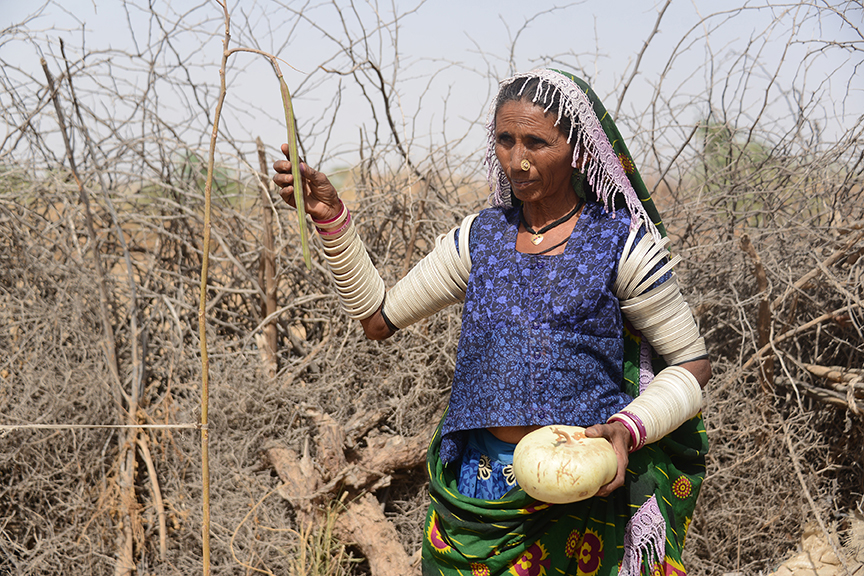
Sustainable farming and kitchen gardening impacts everything from the air we breathe to the carbon footprints we leave behind. Community World Service Asia has been working with the most vulnerable, flood and drought affected rural communities by promoting sustainable agriculture among them to improve their food security, health and nutrition. These activities are allowing community members to sustain livelihoods, ensure good well-being and be an active part of preserving their environment.
Growing your own food allows you to stop relying solely on traditional methods of purchasing your produce from a grocery store. When you buy foods from these shops, you should take into consideration the sad, but true, fact that these foods travel several miles before ever being consumed. Not only does this impact the freshness and flavor of the food, but more importantly, this emits dangerous amounts of carbon emissions and waste associated with air freight and other transportation methods into the atmosphere. The concept of kitchen gardening is helping to reduce the high amounts of burning fossil fuels that fill our environment as a direct result of importing foods from commercial farmers. This initiative is also reducing waste from food packaging materials such as man-made plastics and cardboard, that also travel hundreds and thousands of miles. Women in Sindh feel safer and satisfied knowing what they are eating and what has gone into producing their food.
Under its Livelihoods portfolio, CWSA has conducted 291 workshops for more than five thousand people, a majority of these rural women, on kitchen gardening since 2015. Through these trainings, rural communities, especially women, have started growing kitchen gardens in their homes and have applied low-cost irrigation methods in their agrarian farming.
Introducing Eco-Friendly Farming
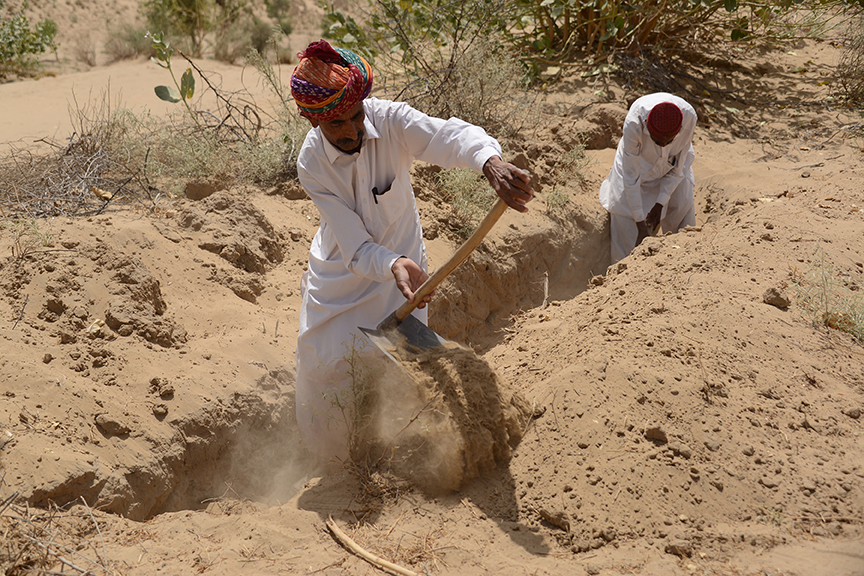 Most local communities in interior Sindh rely heavily on agriculture, but farmers in this region have struggled to cultivate bountiful harvests in the vicinity due to extreme water scarcity, harsh weather conditions and limited knowledge and resources on sustainable farming.
Most local communities in interior Sindh rely heavily on agriculture, but farmers in this region have struggled to cultivate bountiful harvests in the vicinity due to extreme water scarcity, harsh weather conditions and limited knowledge and resources on sustainable farming.
Under its food security projects, CWSA promotes sustainable farming and agri-based enterprises and provides continuous technical support and guidance on business development to rural farmers to enable them to achieve high quality agricultural produce. To further strengthen the skills and expertise of these agrarian communities, CWSA facilitated six exposure visits of 476 farmers, including men and women from twenty-five villages, to renowned agricultural research institutes in Sindh. During these visits, the community members observed multiple ongoing researches and agricultural activities. Some of these included kitchen gardening activities using drip irrigation systems, pitcher gardening schemes, solar desalination units and hydroponic cultivation systems. They were also familiarised with the use of bio fertilisers as one of the most important components of integrated nutrient management, being cost effective as well as being a renewable source of nutrients to supplement chemical fertilisers.
Through workshops on sustainable farming, 13,125 farmers, more than 50% women, from ninety villages in Sindh have been trained on sustainable agriculture. Communities have learned about crop production sustainability and productivity in changing climatic conditions. Most of these trainings focused on increasing productivity in agriculture and the level of economic prosperity among target communities while working on resource and environment conservation.
Improving ecosystems by restoring natural balance
 Afforestation is key to sustaining the ecosystem and accelerating socio-economic development. Trees have remained a main contributor for sustaining resources including food, fiber, livelihood resources and water. Community World Service Asia has launched aeroculture[1] campaigns with farming communities in Sindh. These campaigns have promoted and enhanced biodiversity and mitigated adverse impacts of climate change in the areas that we work. One of the more long-term outcomes of the campaigns has been to provide an alternative livelihood source to water-deprived farming communities in the area. Tree Plantation activities have strengthened peoples’ bond with nature and helped purify the environment.
Afforestation is key to sustaining the ecosystem and accelerating socio-economic development. Trees have remained a main contributor for sustaining resources including food, fiber, livelihood resources and water. Community World Service Asia has launched aeroculture[1] campaigns with farming communities in Sindh. These campaigns have promoted and enhanced biodiversity and mitigated adverse impacts of climate change in the areas that we work. One of the more long-term outcomes of the campaigns has been to provide an alternative livelihood source to water-deprived farming communities in the area. Tree Plantation activities have strengthened peoples’ bond with nature and helped purify the environment.
A variety of fruit and plant saplings such as Sapota, Lemon, Azarirachta indica (neem), Moringa, Falsa, Jujube and Guava, have been distributed among 690 targeted agrarian families of Badin and Umerkot. As many as 34,192 samplings were given out during the campaign that chanted the slogan “Let’s make a promise to grow more trees.”
Ensuring human wellbeing and environmental health through Fuel-Efficient Stoves
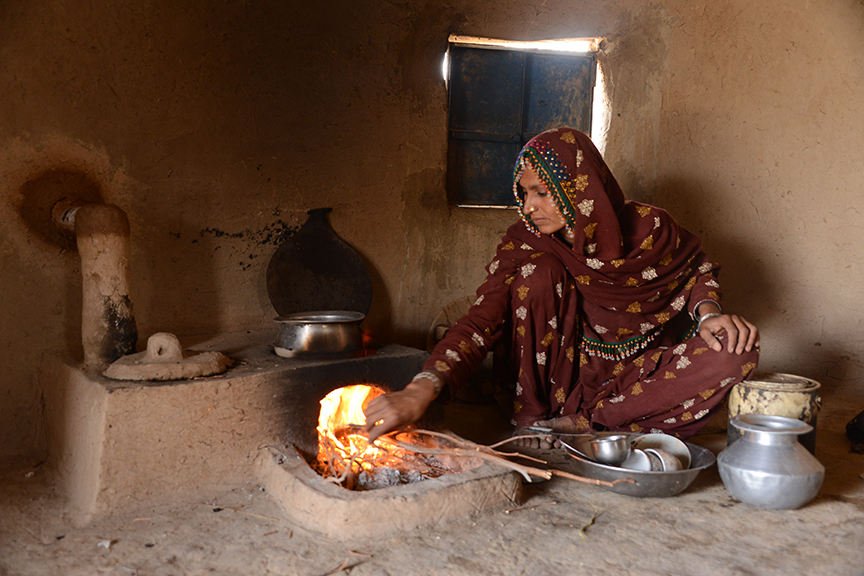 To reduce smoke emissions and decrease deforestation, CWSA, under its Climate Action and Risk Reduction portfolio, is training women on effectively using and adopting a new technology of fuel-efficient stoves in their homes. The fuel-efficient stove is an energy system that has a positive impact on the ecosystem while providing basic cooking needs. The stoves are made of mud and straw enabling caretakers in the house to cook on two burners simultaneously while being able to control the flame at a required temperature. As a result, it reduces smoke emission and fuelwood consumption. A total of forty-seven trainings have been conducted by women community mobilizers for almost a thousand rural women on the use of the stoves and raising awareness among them on its environment-friendly nature. A cleaner environment and reduction in kitchen expenses has been seen as a direct impact of these trainings. More than three thousand stoves have been effectively installed in 2002 households in 16 villages of Umerkot district of Sindh province since 2019.
To reduce smoke emissions and decrease deforestation, CWSA, under its Climate Action and Risk Reduction portfolio, is training women on effectively using and adopting a new technology of fuel-efficient stoves in their homes. The fuel-efficient stove is an energy system that has a positive impact on the ecosystem while providing basic cooking needs. The stoves are made of mud and straw enabling caretakers in the house to cook on two burners simultaneously while being able to control the flame at a required temperature. As a result, it reduces smoke emission and fuelwood consumption. A total of forty-seven trainings have been conducted by women community mobilizers for almost a thousand rural women on the use of the stoves and raising awareness among them on its environment-friendly nature. A cleaner environment and reduction in kitchen expenses has been seen as a direct impact of these trainings. More than three thousand stoves have been effectively installed in 2002 households in 16 villages of Umerkot district of Sindh province since 2019.
Ecosystem restoration can take many forms: Growing trees, making cities greener, rewilding gardens, changing diets or cleaning up rivers and coasts. This is the generation that can make peace with nature so let us all join hands to play an active role in Reimagining, Recreating & Restoring our precious ecosystem.
[1] A method of growing plants without soil by suspending them above sprays that constantly moisten the roots with water and nutrients.
Launching an Association of Rural Women Entrepreneurs to empower Local Women Artisans in voice and spirit
To effectively empower women socially and economically and reduce economic inequality, it is critical to encourage women in rural entrepreneurship. Rural women’s entrepreneurship is a relatively recent phenomenon in Pakistan, and policy efforts to encourage rural women’s interest in entrepreneurship need more work in well-targeted ways. The absence of or lack of awareness of entrepreneurial processes is having a significant impact on the enterprising capability of aspiring rural women entrepreneurs in the country. Furthermore, their lack of experience or expertise in formal enterprises’ management and marketing affairs further impacts their potential for business expansion and profitability.
Community World Service Asia (CWSA) has worked with rural women artisans on enhancing their skills, providing them exposure and promoted their craftsmanship in the national and regional market for more than a decade. CWSA has worked with over a thousand women artisans through its livelihoods programme, giving them a platform to enhance their embroidery and stitching skills and become economically empowered. We have particularly worked towards creating and establishing many market linkages for these artisans to expand their clientele and increase demand for their products. We believe that by establishing sustainable links and maintaining partnership models that are tangible in their deliverables and outcomes, we can provide a critical platform for changing rural women’s position from one of vulnerability to one of decision makers and successful change makers.
By creating or participating in a formal Chamber of Commerce, women entrepreneurs can avail more opportunities to prove their economic clout and convince the government and large corporations to pay attention to specific requirements of women in the workplace and in the enterprise sector. The establishment of an active association specifically focused on women will ensure mentoring, information sharing, simplification of processes and support to rural businesses through policy lobbying.
To develop a pertinent platform, an Association of Rural Women Entrepreneurs is in the process of being registered with the Women Chambers of Commerce and Industry of Pakistan, which will ensure representation of thirty rural artisans as members. CWSA’s team supported the women artisans to prepare and submit all required documents for the registration of the association, including SIM cards, national identification cards and complete profiles of each artisan. Shaiyanne Malik, CWSA’s consultant on women’s skill building and empowerment projects, is in close coordination with the Women Chambers of Commerce and Industry of Pakistan to process and complete the registration of the association successfully. The association will promote entrepreneurship of rural artisans and help rural women connect with business hubs and institutes that will further help them achieve social and economic empowerment.
The primary goal of this association is to give technical assistance and coaching to women who are starting businesses, as well as to promote initiatives from the Export Development Funds (EDF) that are specially targeted for women. It will provide women economic liberty as well as an effective voice to echo their issues, challenges and needs. The chamber will assist rural women in building and operating successful and secure businesses and careers, along with gaining access to government contracts and developing their leadership skills.
This association will be dedicated to changing the economics of business and labour markets, as well as removing impediments to long-term business and economic growth of women in rural regions. In the future, the association will look at funding and capacity-building options, along with promoting the work and products of these rural artisans on a global scale.
Improving community well-being, nutrition and living standards through enhancing disaster resilience against droughts in Sindh, Pakistan
Sodho is the President of the Village Management Committee and Disaster Risk Reduction (DRR) Committee of Male Jo Par Village in Umerkot, Pakistan. He has actively been working to promote sustainable farming practices and build community awareness on DRR to enhance community resilience on recurrent hazards and climate change impacts. The Village Management and the DRR Committees[1] were established in September 2020 under Community World Service Asia’s emergency response project[2], supported by the Ministry of Foreign Affairs, Japan.
“I have coordinated and helped the project team conduct 19 trainings focused on kitchen gardening, fuel efficient stoves, sustainable agricultural practices and DRR since last year. It is a relief to see that our people have the knowledge and skills to protect themselves from natural hazards.”
On September 24th, 2020, an orientation for VMC members was organised to share project objectives and to familiarise members with the role of the committee and as individual members.
“All 15 members, seven women and eight men, were explained their responsibilities as VMC members. We were taught on how and when to coordinate with the project team and how we can contribute in organising project activities. By the end of the training I was also elected as the President of the committee.”
Sodho, along with fifteen other community members, participated in a training on DRR held in October 2020. All training participants shared and learned about common natural and man-made hazards such as earthquakes, floods and fire, experienced in the region.
“The knowledge on DRR was new to the community members. They now know of and are well aware of the different disasters that their people are faced with and have identified ways of alleviating and lessening its effects. Through the training, communities were provided technical knowledge on all kinds of hazards, developing disaster prevention plans and the importance and methods of raising community awareness on DRR.”
Sodho shared a recent accident where a fire broke out at a house in a nearby village. The family was saved but they suffered a massive loss as all their essential belongings and household items were burnt.
“As an active member of the VMC, I immediately called for a meeting to discuss how we can collect donations and help the family recover from the loss. We were able to collect some clothes, food items and essential household items for the family. Through the immediate help, the family found some relief and were hopeful to recover from the monetary and infrastructural loss sooner.”
“VMC members also organised a lesson learning session for their local communities on what they had learned at the DRR training to further enhance community knowledge and capacity on preparedness and mitigation. To overcome natural and man-made disasters, the participants were told about the different disasters and how to minimize the destruction they bring to affected areas. We also shared the story of the house-fire as an example and conducted drills to show what items to save first in the case of a fire and how to prevent the damage caused by such disasters.”
Kitchen gardening, primarily engaging women in the target villages, is another key component of the project. Sodho was personally quite interested in this initiative as having an opportunity to grow healthy vegetables at home seemed like a blessing and was a new concept introduced in the village.
“I saw the benefits of kitchen gardening immediately when the team shared the concept. Growing healthy vegetables at home can bring good health to families and save money as well which was otherwise mostly consumed on purchasing vegetables from the market.”
“I encouraged all women in the village including my own wife to participate in the kitchen gardening trainings. In the last winter season, my wife grew white radish, carrots, spinach, lady fingers and pumpkin in her new kitchen garden. I could see how much she enjoyed working and bringing seeds of different vegetables and fruits from the market to grow in her garden. She is now growing watermelon, guar[3], pumpkins, bottle gourd and lady fingers.”
Sodho further added that their village, Male Jo Par, has existed for the past hundred years and in these many years no-one had ever thought of starting kitchen gardening.
“We reside in the remote areas of Umerkot. The agriculture fields are faced by severe water scarcity. The land has low productivity due to unfertile soil and lack of water. We never thought of growing vegetables in our homes so conveniently with the help of home-made fertilisers and compost. Today, families in Male Jo Par grow garden-fresh vegetables on a daily basis, improving the quality and quantity of their food consumption, nutrition and well-being.”
Sodho also participated in a training session focused on sustainable agricultural practices for farmers, conducted in December 2020 under the project. Ten other small-scale farmers took part in this training.
“Before we took the training, all of us farmers stocked all seeds together in plastic containers and could not differentiate good ones from the bad ones. We would plough the land and sow all the seeds. Consequently, not all crops would grow well. The money that we spent ploughing and harvesting the land would be wasted as the produce would not be as fruitful as expected. This year was different. We stocked the seeds in Stoneware Pots (Matka) and before sowing them, we dried the seeds for at least three days under the sun. As a result, we had a good harvest this year.”
Our village has seen a positive change since the initiation of the DRR project. There has always been severe water scarcity in our area. The RO plant[4], which is being constructed in our village, will also help our people and those of surrounding villages to a great extent. It will provide clean drinking water at a walking distance. Our wives and daughters will not have to travel far places to collect water.”
[1] These are community based structures, members consisting of community people, who are responsible to coordinate project activities and awareness building. They are the key for sustainability and viability of project activities and mobilization of available local resource.
[2] Enhancing disaster resilience against droughts in Sindh Province
[3] Guar is an important legume crop. It is cultivated for fodder as well as for grain purpose.
[4] A reverse osmosis plant is a manufacturing plant where the process of reverse osmosis takes place. Reverse osmosis is a common process to purify or desalinate contaminated water by forcing water through a membrane.


